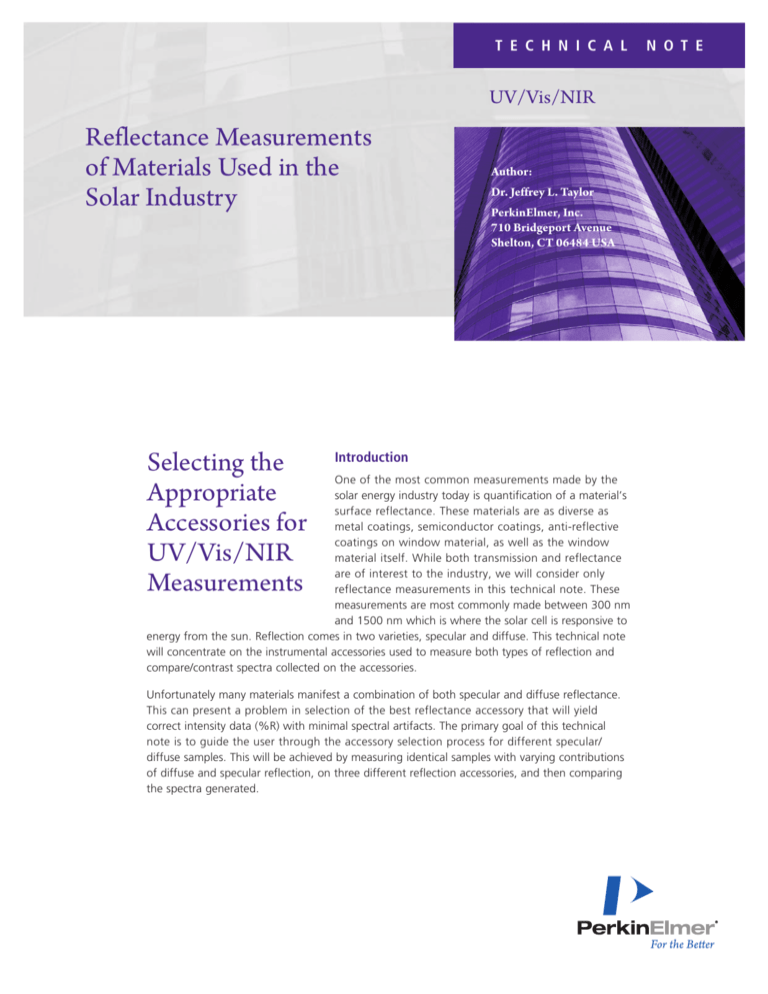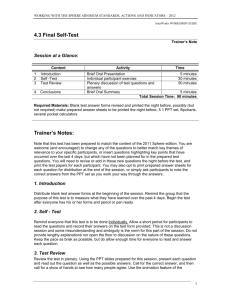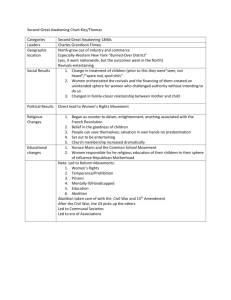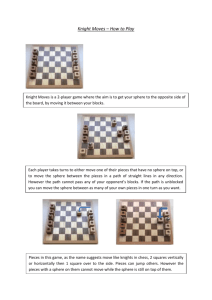
T e c h n i c a l
UV/Vis/NIR
Reflectance Measurements
of Materials Used in the
Solar Industry
Selecting the
Appropriate
Accessories for
UV/Vis/NIR
Measurements
Author:
Dr. Jeffrey L. Taylor
PerkinElmer, Inc.
710 Bridgeport Avenue
Shelton, CT 06484 USA
Introduction
One of the most common measurements made by the
solar energy industry today is quantification of a material’s
surface reflectance. These materials are as diverse as
metal coatings, semiconductor coatings, anti-reflective
coatings on window material, as well as the window
material itself. While both transmission and reflectance
are of interest to the industry, we will consider only
reflectance measurements in this technical note. These
measurements are most commonly made between 300 nm
and 1500 nm which is where the solar cell is responsive to
energy from the sun. Reflection comes in two varieties, specular and diffuse. This technical note
will concentrate on the instrumental accessories used to measure both types of reflection and
compare/contrast spectra collected on the accessories.
Unfortunately many materials manifest a combination of both specular and diffuse reflectance.
This can present a problem in selection of the best reflectance accessory that will yield
correct intensity data (%R) with minimal spectral artifacts. The primary goal of this technical
note is to guide the user through the accessory selection process for different specular/
diffuse samples. This will be achieved by measuring identical samples with varying contributions
of diffuse and specular reflection, on three different reflection accessories, and then comparing
the spectra generated.
N o t e
accessory design. The most common types of absolute specular
accessories are the VN, VW and Universal Reflectance Accessory
(URA). The VN (single sample bounce) and VW (double sample
bounce) accessories are named from the beam path geometry of
the background (V) and the sample (N and W) collection
modes. Mirror movement between background and sample
modes is by hand. The URA is a variable angle, single sample
bounce, VN style accessory where the mirror movement and
incidence angle selection are totally automated by electronic
stepper motors.
Figure 1. Types of reflection.
Specular reflection (Figure 1-A) is generated by a smooth surface.
The light ray’s angle of incidence is equal to the angle of reflection;
therefore, specular materials frequently produce images on their
surface (mirror). Specular reflectance is measured by a number
of different types of accessories (VW, VN, and Universal Reflectance
Accessory).
General Integrating Sphere – Figure 2 shows the general optical
design for an integrating sphere. The transfer optics for the reference
beam (M3, M4) and the sample beam (M1, M2) direct the light
through open holes in the Spectralon® sphere body into the
sphere where they strike the sample reflectance port and reference
port areas. In the interior of the sphere you can see through the
center-mount port the baffles that shield the detectors from first
bounce sample reflectance or transmittance. Under normal
measurement conditions the sample reflectance port and the
reference port are covered by either a Spectralon® plate or sample
material. The transmittance port and reference beam entry port
are usually open during reflectance measurements and are areas
where light diffusely reflected from the sample can escape from
the sphere.
Diffuse reflection (Figure 1-B) is generated by a rough surface.
In this case, the light ray’s incidence angle gives rise to a multiplicity
of reflection angles; therefore, images are not produced. Diffuse
reflectance is how people see the world since the vast majority of
objects in the world are diffuse reflectors. Diffuse reflection is
measured by integrating spheres, two sizes are available, small
(60 mm diameter) and large (150 mm diameter).
Definitions
Relative Specular Reflectance Accessory – This refers to the
simplest and least expensive specular accessory. A relative specular
accessory must use a calibrated reference mirror to measure the
background values. When samples are measured, a mathematical
calculation must be performed using the known values from the
reference mirror to correct the samples to absolute reflectance.
Absolute Specular Reflectance Accessory – This type of specular
accessory does not require a reference mirror to make an absolute
reflectance measurement. The accessory is designed with moving
transfer optics (mirrors) that have different configurations for
background collection and sample measurement. As long as the
transfer optics move in such a way that the same mirrors are used
for the background and sample collection, and the total distance
along the beam path is the same between background and sample
collection, then the reflectance measurement is absolute by
2
Figure 2. Basic optical layout for a double beam integrating sphere.
60 mm Integrating Sphere – This is a low cost reflectance
accessory that measures both diffuse and total reflectance. It consists
of a hollow 60 mm sphere of highly reflective Spectralon® polymer
with two ports for the sample and reference beam to enter and
two ports for placement of sample and reference material.
Background collection is performed by placing two Spectralon®
plates at the sample and reference ports. Since Spectralon® has a
diffuse reflectance of > 99.0 %R, the reflectance of spheres can be
assumed to be close to absolute %R. Because of the size of the
sphere and the lack of baffling of the detectors in the sphere from
first bounce sample reflectance, this sphere type is subject to
several types of spectral artifact such as incorrect %R values and
steps at instrumental filter and detector change points.
150 mm Integrating Sphere – This larger 150 mm sphere operates
in a similar fashion to its smaller 60 mm counterpart. The two
notable differences are its larger sphere diameter and the baffling
of the internal detectors via Spectralon® coated paddles. The
larger sphere size makes the port area for the sample and reference
beams a smaller proportion of the total sphere area than in the
smaller 60 mm sphere. The baffles prevent a first bounce reflectance
ray from the sample from striking the detectors. The ideal number
of bounces in a sphere is around ten. The 150 mm sphere is
typically known as a standard color sphere. Its design is controlled
by the color industry regulatory agencies to ensure uniformity of
data between spheres manufactured by different companies. Its
design also eliminates or reduces artifacts present in smaller nonregulation spheres.
to enter. Light that is reflected from the sample can escape through
these ports and is therefore not measured. The larger the sphere
is, the smaller the area of the ports to the total surface area of the
sphere. The spectra from the 150 mm sphere is higher because
the relative hole to surface area is smaller than the 60 mm sphere.
Therefore, more diffusely reflected light from the sample is collected. So which spectra are correct? Neither technically. The
150 mm sphere data are, however, much closer to the absolute
diffuse reflectance of the sample (within 1 or 2 %R) than the
60 mm sphere.
Experimental
Reflectance accessory evaluation employed four samples that
span the range of typical solar industry materials. Sample 1 is a
diffuse material with a small specular component, Sample 2 is a
clear specular coating of low intensity, Sample 3 is a colored
specular coating of medium intensity, and Sample 4 is a specular
semi-conductor material of high intensity.
Each of the four samples was measured on a 60 mm integrating
sphere, a 150 mm integrating sphere, and a URA accessory. All
sphere measurements were 8 degree hemispherical in total
reflectance collection mode. The URA measurements were at
8 degree angle of incidence. All other instrumental parameters
were the same for all four samples.
Figure 3. Spectra of Sample 1 (textured sample).
Black line – measured on 150 mm sphere.
Red line – measured on 60 mm sphere.
Two basic characteristics of integrating spheres relate to their
photometric accuracy and freedom from such artifacts as steps at
filter and detector changes. These are sphere size (diameter) and
the presence of internal baffles that protect the detectors from
first bounce reflectance from the sample. The nature of the artifacts
and inaccuracies depends on the sample’s reflection intensity and
properties (specular or diffuse).
What happens when you measure a totally specular sample with
little or no diffuse component in a sphere? In order to answer this
question we need understand what happens to the light inside
the sphere. Figure 4A depicts how both diffuse and specular light
reflects off the sample into the sphere. The diffuse reflected light
will illuminate the entire area inside the sphere through 380 degrees.
The specular reflected light will strike only an area along the
midline of the sphere in the vicinity of the transmittance port.
Photographs of this area, taken via a webcam inserted inside the
sphere, are shown in Figures 4B, C, and D.
Figure 3 plots the spectra from Sample 1 (diffuse material with
a small specular component) measured by the two types of integrating spheres. The spectra are qualitatively similar yet different
quantitatively. The textured sample in Figure 3 is a diffuse sample.
So why are the spectra different when measured on different size
spheres? All spheres must have ports for the instrumental beam
The photograph in Figure 4B shows the even illumination of
the sphere from a 100% diffuse reflectance sample. However, if a
specular sample is placed at the sample port, a ‘hot spot’ is formed
on the wall of the sphere. This hot spot is photographed in
Figures 4C and 4D for a 10% R and a 90% R specular sample
respectively. Note that there is little illumination of the sphere
Results and Discussion
A
B
C
D
Figure 4.
3
interior and only the concentrated hot spot shows up. The
brightness of the hot spot is directly related to the reflectivity of
the specular sample. Errors result from the fact that the background correction performed with the diffuse Spectralon® plate
illuminates the sphere differently from the specular sample hot
spot illumination. The resulting different sphere interior images
that the detector measures between background and sample
causes error artifacts.
Figure 5 plots the spectra from Sample 2 (clear specular coating
of low intensity) measured by the two types of integrating spheres
plus the URA specular accessory. Note that the 150 mm sphere
(black) and URA (green) agree very closely. However, the spectra
for the 60 mm sphere has a higher %R and suffers from a small
step artifact at the detector change point at 860 nm. It is interesting
that with specular samples the highest %R value is from the
60 mm sphere (compare with Figure 4). This is because the hot
spot dominates and concentrates the light the detector measures.
In addition, since there is little diffuse light in the sphere, there is
no light to escape from the open ports.
Figure 7 plots the spectra from Sample 4 (specular semi-conductor
material of high intensity) measured by the two types of integrating
spheres plus the URA. When the reflectance intensity becomes
high enough there is disagreement for the same sample throughout all three reflectance accessories. There is, with this sample, a
pronounced difference (5%R) between spectra from the 60 mm
sphere and the URA. In addition, the 150 mm sphere and the
URA spectra no longer share any overlap. The detector step at
860 nm in the 60 mm sphere spectrum is also now very pronounced.
Figure 6. Spectra of Sample 3 (medium intensity specular sample).
Black line– measured on 150 mm sphere.
Red line – measured on 60 mm sphere.
Green line – measured on Universal Reflectance Accessory.
Figure 5. Spectra of Sample 2 (low intensity specular sample).
Black line – measured on 150 mm sphere.
Red line – measured on 60 mm sphere.
Green line – measured on Universal Reflectance Accessory.
Figure 6 plots the spectra from Sample 3 (colored specular coating
of medium intensity) measured by the two types of integrating
spheres plus the URA. This sample is somewhat unusual because
of the increased spectra structural detail and is a more intense
specular sample. However, it follows the general pattern of Sample 3.
The 60 mm sphere spectrum suffers from pronounced wavelength shift and intensity offset. There are now irregularities
between the 150 mm sphere and URA spectra. The step at the
detector change in the 60 mm sphere data is most likely masked
by the steep slope of the spectrum at this wavelength.
4
Figure 7. Spectra of Sample 4 (high intensity specular sample).
Black line – measured on 150 mm sphere.
Red line – measured on 60 mm sphere.
Green line – measured on Universal Reflectance Accessory.
Conclusion
1) For accurate and artifact free data, highly or totally specular
samples should be measured on a suitable absolute specular
reflection accessory such as a URA, VN, or VW accessory.
Integrating spheres can only provide approximate specular
reflection data with the degree of error depending on the
nature of the sample and the intensity of its reflection.
2) In the solar industry however, total reflection measurements
must be obtained for highly specular samples. Under these
circumstances integrating spheres can provide acceptable
spectra for diffuse and combination diffuse/specular samples.
In addition, most spheres have the ability to measure either
diffuse only and total reflectance (diffuse plus specular).
In diffuse-only mode the sphere is configured to allow the
specular component to exit the sphere via an open port.
CAUTION: It is not possible to obtain an absolute specular
spectrum by measuring the total and diffuse reflection spectra
and then subtract. The port that allows the escape of the specular
component also permits a small amount of diffuse component
to escape, thus the subtraction calculation will yield an inaccurate,
higher than expected %R. The primary purpose of the diffuseonly mode is to eliminate specular glare from diffuse sample
measurements.
3) The standard color 150 mm sphere is the only sphere that
will give accurate and comparable spectra between different
instrument/sphere models. The smaller 60 mm sphere with
its larger port to surface area ratio and lack of detector baffling
will cause lower %R measurements and step artifacts in the
spectra respectively.
4) Some solar industry materials are highly specular but also
contain small amounts of a diffuse component that make
measurement on an absolute specular accessory problematic.
For these types of samples, a 150 mm integrating sphere can
be employed with the following procedure. A calibrated front
surface aluminum mirror, rather than the Spectralon® plate,
is used for the background correction at the sample port.
A mathematical correction using the values of the calibrated
mirror is employed to correct the raw spectral data to
absolute %R (the %RC mode automatically calculates this
correction in UV/WinLab™ software). The aluminum mirror
replicates the hot spot of the specular sample, thereby eliminating
the hot spot artifact and yielding acceptable absolute %R data.
Best results are achieved when the intensity of the sample and
calibrated mirror are of similar %R values.
5) The 60 mm sphere is a lower cost alternative when the primary
use is as a transmittance collection sphere or where qualitative
or relative quantitative spectra are of interest.
Ordering Information
Part Number Description
L6020208
Universal Reflectance Accessory (UV/Vis only) for L650 and L850
L6020202
Universal Reflectance Accessory (UV/Vis/NIR) for L950
L6020358
Universal Reflectance Accessory (UV/Vis/NIR) for L1050
L6020203
Integrating Sphere Accessory – 60 mm PbS Detector
L6020204
Integrating Sphere Accessory – 150 mm PbS Detector
PerkinElmer, Inc.
940 Winter Street
Waltham, MA 02451 USA
P: (800) 762-4000 or
(+1) 203-925-4602
www.perkinelmer.com
For a complete listing of our global offices, visit www.perkinelmer.com/ContactUs
Copyright ©2009, PerkinElmer, Inc. All rights reserved. PerkinElmer® is a registered trademark of PerkinElmer, Inc. All other trademarks are the property of their respective owners.
008601_01






